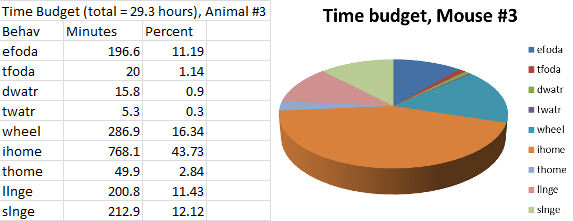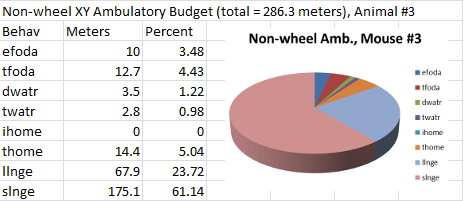Automated behavior analysis: The basics of EthoScan
When mice (or rats) are wandering around their Promethion system cages and simply being mice (or rats), they interact with the various sensors in their cages – the mass sensors attached to their food and water dispensers, their body mass sensor, their running wheel, and their X-Y open-field position sensor, for example. In the Promethion system, each interaction is precisely recorded with a heartbeat of one second.
This makes it possible to construct a detailed analysis of the animal's behavior. Looking at Promethion data, you can easily see how this is achieved. In this 20-minute section, zoomed in from a much longer recording, you can see the raw data from four sensors - water dispenser mass (blue), habitat mass (green; this allows body mass to be measured each time the animal enters or leaves the habitat), food hopper mass (red), and running wheel revolutions (orange), with a time resolution of one second. The mouse's transitions between different behaviors are very obvious, the times at which they occur are precisely known, and they are quantifiable. (To make the graph clearer, the various sensor data are not to the same scale, and not all of the sensor data are shown). Click on the picture below to embiggen it.
So, in this example, we see the transition (starting at the left) from running, to lounging about (without touching anything) for a few seconds, to entering the habitat (and thus being weighed), to running again, to touching the habitat without entering it, to running, to touching the habitat again, to drinking (notice the reduction in water dispenser mass), to eating (see the reduction in food hopper mass), to lounging and then touching the home habitat, to running, to entering the home, to running, to touching the food hopper without eating, to drinking - you get the picture!
Now we can invoke ExpeData's EthoScan automated behavior analysis software. It gives us several outputs. The simplest is a list of behaviors. Let's look at such a list, for the exact sequence we see above. Here is that section of data shown in Excel. Each behavior has a five letter code - WHEEL for wheel-running, SLNGE and LLNGE for a short or long lounge (< 60 and >= 60 seconds), THOME and IHOME for touching or actually entering its habitat, TFODA and EFODA for touching or actually eating from food dispenser A, TWATR and DWATER for touching or actually drinking from the water dispenser. A section of particular interest is highlighted. (Click to embiggen.)
As you can see, each behavior has a start and end time and date, a duration in seconds, and an "amount", a quantification based on the behavior - revolutions for WHEEL, body mass for IHOME, mL of water consumed for DWATR, grams of food eaten for EFODA, and centimeters locomoted for SLNGE. Much of this information is impossible to obtain from video analysis or other behavior quantification systems - yet this rich mine of data is a standard feature with Promethion, which knows how to use its sensors intelligently.
If you look at the highlighted section, you can see how the mouse's body mass rises abruptly after eating and drinking. This gives you mass balance data you can't get any other way.
Ah, but there's more. Having the list of behaviors, EthoScan now gives you time budgets...

And it gives you non-wheel ambulatory budgets...

And it gives you with-wheel ambulatory budgets... all automatically. Note the huge contribution from the running wheel. This mouse ran over 4 kilometers in a 24-hour period - and that's actually pretty lazy by mouse standards.

But wait, there's more! Given a particular behavior, what is the probability that a given behavior will occur next? What we need, in short, is a transition probability matrix. And yet again, EthoScan obliges. Here it is.

For example, after eating food (EFODA), there is a small likelihood that this mouse will drink water or touch the water dispenser without drinking (DWATR, TWATR), but it's very likely (> 80%) to walk about the cage for a few seconds (SLNGE) before doing anything else. It won't go straight to the wheel after eating or drinking. But after a short lounge the most likely behavior is to run on the wheel. You can, in effect, see how the mouse's mind works, and how it balances the transitions between behaviors and their duration and quality. And all of this information is hard, numeric data that can be tested and rigorously compared across animals, strains, knockouts, dosages, treatment groups, and so on.
And it all comes, complete and at no extra cost, with any Promethion system, whether you use behavioral analysis or not. In fact you can even opt to use a Promethion system for behavioral analysis only. You can always add metabolic measurement later if you need it.
I still remember when EthoScan occurred to me. It was one of those "aha", and "I remember exactly where it happened" moments. Examining a Promethion recording similar to the one that started this blog post, the idea for EthoScan sprung fully formed into my mind - using the rich sensor data from Promethion in a way never intended when the system was designed. But somewhere deep in my mind Jeanne Altmann's classic 1974 paper (Observational Study of Behavior: Sampling Methods) had been percolating since undergraduate days. To use her terminology, EthoScan boils down to simultaneous Focal Animal behavioral sampling of all animals at once, with one-second sampling resolution - and with no wandering of the observer's attention. Sometimes the best things happen without conscious planning.
If you have any questions, don't hesitate to contact me.
-- John Lighton
- Log in to post comments

